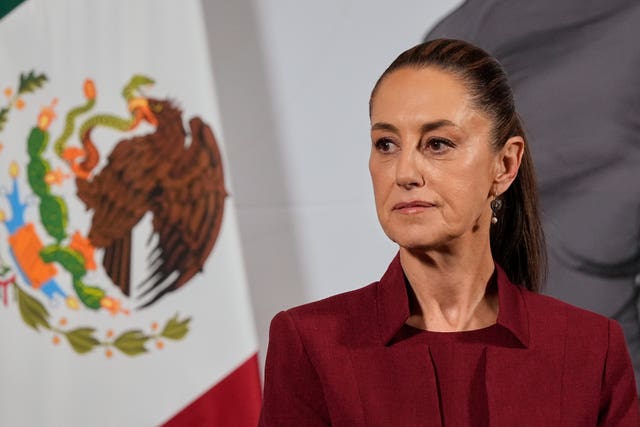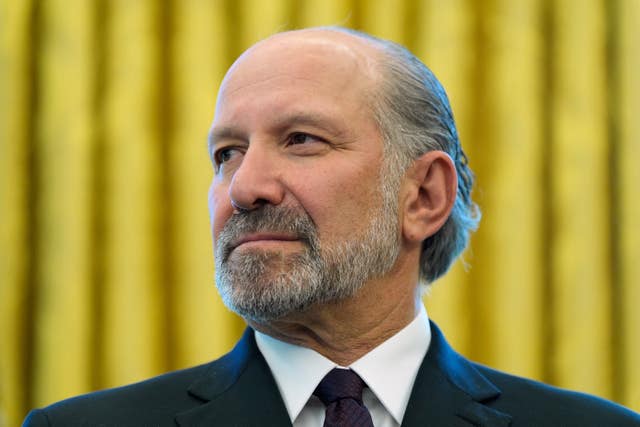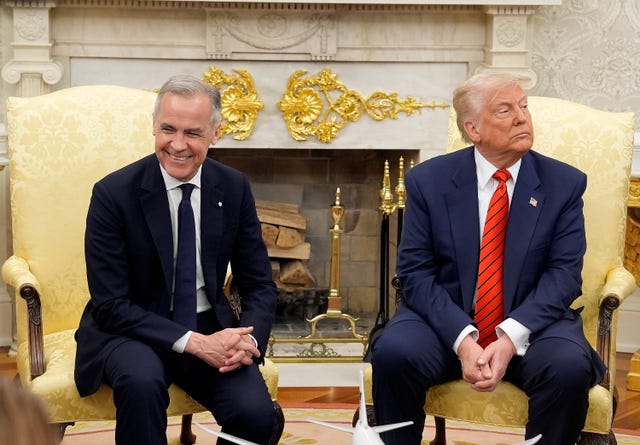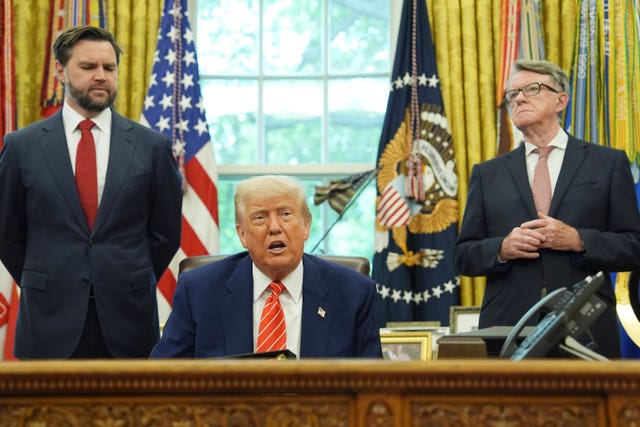There has also been a sense of whiplash from Mr Trump’s back-and-forth tariff threats and responding retaliation seen over the last few months.
Here’s a timeline of how events unfolded:
– January 20
Donald Trump is sworn into office. In his inaugural address, he again promises to “tariff and tax foreign countries to enrich our citizens”. And he reiterates plans to create an agency called the External Revenue Service, which has yet to be established.
On his first day in office, Mr Trump also says he expects to put 25% tariffs on Canada and Mexico starting on February 1, while declining to immediately flesh out plans for taxing Chinese imports.
– January 26
Mr Trump threatens 25% tariffs on all Colombia imports and other retaliatory measures after President Gustavo Petro’s rejects two US military aircraft carrying migrants to the country, accusing Mr Trump of not treating immigrants with dignity during deportation.
In response, Mr Petro also announces a retaliatory 25% increase in Colombian tariffs on US goods. But Colombia later reversed its decision and accepted the flights carrying migrants. The two countries soon signalled a halt in the trade dispute.
– February 1
Mr Trump signs an executive order to impose tariffs on imports from Mexico, Canada and China – 10% on all imports from China and 25% on imports from Mexico and Canada starting on February 4. Mr Trump invoked this power by declaring a national emergency — ostensibly over undocumented immigration and drug trafficking.
The action prompts swift outrage from all three countries, with promises of retaliatory measures.
– February 3
Mr Trump agrees to a 30-day pause on his tariff threats against Mexico and Canada, as both trading partners take steps to appease Mr Trump’s concerns about border security and drug trafficking.

– February 4
Mr Trump’s new 10% tariffs on all Chinese imports to the US still go into effect. China retaliates the same day by announcing a flurry of countermeasures, including new duties on a variety of American goods and an anti-monopoly investigation into Google.
China’s 15% tariffs on coal and liquefied natural gas products, and a 10% levy on crude oil, agricultural machinery and large-engine cars imported from the US, take effect on February 10.
– February 10
Mr Trump announces plans to hike steel and aluminium tariffs starting on March 12. He removes the exemptions from his 2018 tariffs on steel, meaning that all steel imports will be taxed at a minimum of 25%, and also raises his 2018 aluminium tariffs from 10% to 25%.
February 13
Trump announces a plan for “reciprocal” tariffs — promising to increase U.S. tariffs to match the tax rates that countries worldwide charge on imports “for purposes of fairness.” Economists warn that the reciprocal tariffs, set to overturn decades of trade policy, could create chaos for global businesses.

– February 25
Mr Trump signs an executive order instructing the Commerce Department to consider whether a tariff on imported copper is needed to protect national security. He cites the material’s use in US defence, infrastructure and emerging technologies.
– March 1
Mr Trump signs an additional executive order instructing the Commerce Department to consider whether tariffs on lumber and timber are also needed to protect national security, arguing that the construction industry and military depend on a strong supply of wooden products in the US.
– March 4
Mr Trump’s 25% tariffs on imports from Canada and Mexico go into effect, though he limits the levy to 10% on Canadian energy. He also doubles the tariff on all Chinese imports to 20%.
All three countries promise retaliatory measures. Canadian prime minister Justin Trudeau announces tariffs on more than 100 billion dollars (£75.4 billion) of American goods over the course of 21 days. And Mexican President Claudia Sheinbaum says her country would respond with its own retaliatory tariffs on US goods without specifying the targeted products immediately, signaling hopes to de-escalate.
China, meanwhile, imposes tariffs of up to 15% on a wide array of key US farm exports, set to take effect March 10. It also expands the number of US companies subject to export controls and other restrictions by about two dozen.
– March 5
Mr Trump grants a one-month exemption on his new tariffs impacting goods from Mexico and Canada for US car makers. The pause arrives after the president spoke to leaders of the “Big 3” automakers — Ford, General Motors and Stellantis.
– March 6
In a wider extension, Mr Trump postpones 25% tariffs on many imports from Mexico and some imports from Canada for a month.
Mr Trump credited Ms Sheinbaum with making progress on border security and drug smuggling as a reason for again pausing tariffs. His actions also thaw relations with Canada somewhat, although outrage and uncertainty remains.
Still, after its initial retaliatory tariffs of 30 billion Canadian dollars (£15.8 billion) on US goods, the government says it has suspended a second wave of retaliatory tariffs worth 125 billion Canadian dollars (£65.6 billion).
– March 10
China’s retaliatory 15% tariffs on key American farm products, including chicken, pork, soybeans and beef, take effect. Goods already in transit are set to be exempt through to April 12, as per China’s Commerce Ministry previous announcement.
– March 12
Mr Trump’s new tariffs on all steel and aluminium imports go into effect. Both metals are now taxed at 25% across the board, with Mr Trump’s order to remove steel exemptions and raise aluminium’s levy from his previously imposed 2018 import taxes.
The European Union takes retaliatory trade action promising new duties on US industrial and farm products. The measures will cover goods from the United States worth some 26 billion euros (£21 billion), and not just steel and aluminium products, but also textiles, home appliances and agricultural goods.
Motorcycles, bourbon, peanut butter and jeans will be hit, as they were during Mr Trump’s first term. The 27-member bloc later says it will delay this retaliatory action until mid-April.
Canada, meanwhile, announces plans to impose more retaliatory tariffs worth 29.8 billion Canadian dollars (£15.6 billion) on US imports, set to go into effect March 13.
– March 13
Mr Trump threatens a 200% tariff on European wine, Champagne and spirits if the European Union goes forward with its previously announced plans for a 50% tariff on American whiskey.
– March 24
Mr Trump says he will place a 25% tariff on all imports from any country that buys oil or gas from Venezuela, in addition to imposing new tariffs on the South American country itself, starting April 2.
The tariffs would most likely add to the taxes facing China, which in 2023 bought 68% of the oil exported by Venezuela, as per the US Energy Information Administration. But a number of countries also receive oil from Venezuela — including the United States itself.
– March 26
Mr Trump says he is placing 25% tariffs on auto imports. These auto imports will start being collected on April 3, beginning with taxes on fully imported cars. The tariffs are set to then expand to applicable auto parts in the following weeks, through to May 3.
– April 2
Mr Trump announces his long-promised “reciprocal” tariffs — declaring a 10% baseline tax on imports across the board starting on April 5, as well as higher rates for dozens of nations that run trade surpluses with the US to take effect on April 9.
Among those steeper levies, Mr Trump says the US will now charge a 34% tax on imports from China, a 20% tax on imports from the European Union, 25% on South Korea, 24% on Japan and 32% on Taiwan. The new tariffs come on top of previously imposed levies, including the 20% tax Mr Trump announced on all Chinese imports earlier this year.
Meanwhile, for Canada and Mexico, the White House says USMCA-compliant imports can continue to enter the US duty-free. Once the two countries have satisfied Mr Trump’s demands on immigration and drug trafficking, the White House adds, the tariff on the rest of their imports may drop from 25% to 12%.

– April 3
Mr Trump’s previously announced auto tariffs begin. Prime Minister Mark Carney says that Canada will match the 25% levies with a tariff on vehicles imported from the US.
– April 4
China announces plans to impose a 34% tariff on imports of all US products beginning on April 10, matching Mr Trump’s new “reciprocal” tariff on Chinese goods, as part of a flurry of retaliatory measures.
The Commerce Ministry in Beijing says it will also impose more export controls on rare earths, which are materials used in high-tech products such as computer chips and electric vehicle batteries. And the government adds 27 firms to lists of companies subject to trade sanctions or export controls.
– April 5
Mr Trump’s 10% minimum tariff on nearly all countries and territories takes effect.
– April 9
The president’s higher “reciprocal” rates go into effect, hiking taxes on imports from dozens of countries just after midnight. But hours later, his administration says it will suspend most of these higher rates for 90 days, while maintaining the recently imposed 10% levy on nearly all global imports.
China is the exception. After following through on a threat to raise levies against China to a total of 104%, Mr Trump says he will now raise those import taxes to 125% “effective immediately”, escalating tit-for-tat duties that have piled up between the two countries. The White House later clarifies that total tariffs against China are actually now 145%, once his previous 20% fentanyl tariffs are accounted for.
China upped its retaliation prior to this announcement, vowing to tax American goods at 84% starting April 10. Also earlier, EU member states vote to approve their own retaliatory levies on 20.9 billion euros (£17.3 billion) of US goods in response to Mr Trump’s previously imposed steel and aluminium tariffs.
The EU’s executive commission does not immediately specify which imports it will tax, but notes its counter tariffs will come in stages — with some set to arrive on April 15, and others on May 15 and December 1.
Separately, Canada’s counter tariffs on auto imports take effect. The country implements a 25% levy on auto imports from the US that do not comply with the 2020 USMCA pact.
– April 10
The EU puts its steel and aluminum tariff retaliation on hold for 90 days, to match Mr Trump’s pause on steeper “reciprocal” levies. European Commission President Ursula von der Leyen says the commission wants to give negotiations with the US a chance but warns countermeasures will kick in if talks “are not satisfactory”.
– April 11
China says it will raise tariffs on US goods from 84% to 125%, in response to Mr Trump’s heightened levies. The new rate is set to begin April 12.
Later, the Trump administration unveils that electronics, including smartphones and laptops, will be exempt from so-called “reciprocal” tariffs. But in the days following, US Commerce Secretary Howard Lutnick signals that this is only a temporary reprieve.
– April 14
Mr Trump says he might temporarily exempt the auto industry from tariffs he previously imposed on the sector, to give carmakers time to adjust their supply chains.
The Trump administration also launches investigations into imports of computer chips, chipmaking equipment and pharmaceuticals, signalling next steps toward imposing tariffs on these sectors.
– April 29
The president signs executive orders to relax some of his 25% tariffs on cars and auto parts aimed at easing import taxes for vehicles that are made with foreign parts, but assembled in the US.
For one year, the administration says it will provide a rebate of 3.75% relative to the sales prices of a domestically assembled car, a figure reached by putting the previously imposed 25% import tax on parts that make up 15% of that price. And for the second year, the rebate would equal 2.5% of the sales price, applying to a smaller share of the vehicle’s parts.
– May 3
The latest round of Mr Trump’s auto tariffs takes effect. The previously announced 25% levies now apply to a range of imported auto parts.
– May 4
Mr Trump threatens a 100% tariff on foreign-made films, while claiming that the movie industry in the US is dying. It is not immediately clear how such a tariff on international productions could be implemented, but Mr Trump says he has authorised the Commerce Department and the US Trade Representative to “immediately begin the process”.
– May 6
The U.S. trade deficit soared to a record 140.5 billion dollars (£105.9 billion) in March as consumers and businesses tried to get ahead of Mr Trump’s tariffs. Federal data showed an enormous stockpiling of pharmaceutical products. The deficit has roughly doubled during the past year.
The US government announces that top officials are set to meet with a high-level Chinese delegation over the weekend in Switzerland in the first major talks between the two nations since Mr Trump sparked a trade war.
– May 7
The Federal Reserve left its key interest rate unchanged at 4.3%, saying that the risks of both higher unemployment and higher inflation have risen due to uncertainty about how and when Mr Trump’s tariffs might impact the US economy.

– May 8
The US and the UK announce a trade deal, potentially lowering the financial burden from tariffs while creating greater access abroad for American goods. Mr Trump said final details were being written up. “In the coming weeks, we’ll have it all very conclusive,” he said.
Britain said the deal will cut tariffs on UK cars from 27.5% to 10%, with a quota of 100,000 UK vehicles that can be imported to the US at a 10% tariff. It also eliminate tariffs on steel and aluminium.
Separately, the European Union published a list of US imports that it would target with retaliatory duties if no solution is found to end Mr Trump’s tariff war. The EU’s executive branch, the European Commission, also said it would begin legal action at the World Trade Organisation over the “reciprocal tariffs” that Mr Trump imposed.











